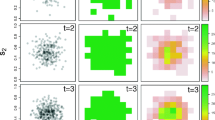Summary
The distributions, with respect to habitat structure, of nine species of eastern-Australian cicadas have been shown to be non-random. The most striking consequence of this non-randomness is a marked inverse relationship between habitat breadth and habitat position (terms defined in text). Eight basic models and 12 derived models were used in conjunction with a canonical space to try to account for the ways in which the species of cicadas were distributed with respect to habitat. Several models produced results that were in reasonable agreement with the observed data. The most parsimonious of these corresponds to analytical results of other workers, such as Diamond's (1975) incidence curves, occurrence sequences (Schoener and Schoener 1983), and probability functions (Adler and Wilson 1985). The distributions of cicadas can be modelled by assuming that the species occupy sites independently of one another. These species of cicadas are unlikely to engage in interspecific competition, which is consistent with independence of distributions.
Similar content being viewed by others
References
Abrams PA (1987) Resource partitioning and competition for shells between intertidal hermit crabs on the outer coast of Washington. Oecologia 72:248–258
Adler GH, Wilson ML (1985) Small mammals on Massachusetts islands: the use of probability functions in clarifying biogeographic relationships. Oecologia 66:178–186
Brown JH (1971) Mechanisms of competitive exclusion between two species of chipmunks. Ecology 52:305–311
Carnes BA, Slade NA (1982) Some comments on niche analysis in canonical space. Ecology 63:888–893
Cody ML (1978) Habitat selection and interspecific territoriality among the sylviid warblers of England and Sweden. Ecol Monogr 48:351–396
Collins SL, James FC, Risser PG (1982) Habitat relationships of wood warblers (Parulidae) in northern central Minnesota. Oikos 39:50–58
Connell JH (1980) Diversity and the coevolution of competitors, or the ghost of competition past. Oikos 35:131–138
Denno RF (1980) Ecotope differentiation in a guild of sap-feeding insects on the salt marsh grass, Spartina patens. Ecology 61:702–714
Diamond JM (1975) Assembly of species communities. Pages 342–444 In: Cody ML, Diamond JM (eds) Ecology and evolution of communities. Belknap Press of Harvard University, Cambridge, Massachusetts, USA
Diamond JM (1978) Niche shifts and the rediscovery of interspecific competition. Am Sci 66:322–331
Diamond JM, Marshall AG (1977) Distributional ecology of New Hebridean birds: a species kaleidoscope. J Anim Ecol 46:703–727
Dueser RD, Shugart HH Jr (1979) Niche pattern in a forest-floor small-mammal fauna. Ecology 60:108–118
Futuyma DJ, Gould F (1979) Associations of plants and insects in a deciduous forest. Ecol Monogr 49:33–50
Hairston NG (1980) An experimental test of an analysis of field distributions: competition in terrestrial salamanders. Ecology 61:817–826
Hairston NG Sr (1986) Species packing in Desmognathas salamanders: experimental demonstration of predation and competition. Am Nat 127:266–291
Jaeger RG (1970) Potential extinction through competition between two species of ter nerstrial salamanders. Evolution 24:632–642
James FC (1971) Ordination of habitat relationships among breeding birds. Wilson Bulletin 83:215–236
James FC, Shugart HH (1971) A quantitative method of habitat description. Audubon Field Notes 24:727–736
Kendall MG, Stuart A (1973) The advanced theory of statistics. Griffin, London, UK
Larson RJ (1980) Competition, habitat selection, and the bathymetric segregation of two rockfish (Sebastes) species. Ecol Monogr 50:221–239
Lawton JH (1982) Vacant niches and unsaturated communities: a comparison of bracken herbivores at sites on two continents. J Anim Ecol 51:573–595
Lawton JH, Strong DR Jr (1981) Community patterns and competition in folivorous insects. Am Nat 118:317–338
MacArthur RH (1972) Geographical ecology. Harper and Row, New York
Mac Nally RC (1985) Habitat and microhabitat distributions in relation to ecological overlap in two species of Ranidella (Anura). Austr J Zool 33:329–338
Mac Nally RC, Doolan JM (1986a) An empirical approach to guild structure: habitat relationships in nine species of eastern-Australian cicadas. Oikos 47:33–46
Mac Nally RC, Doolan JM (1986b) Patterns of morphology and behaviour in a cicada guild: a neutral model analysis. Austr J Ecol 11:279–294
Rice J (1978) Behavioural interactions of interspecifically territorial vireos. I. Song discrimination and natural interactions. Anim Behav 26:527–549
Richardson DH, Wu DM (1970) Least squares and grouping method estimators in the errors in variables model. J Am Stat Assoc 65:724–748
Rotenzweig ML (1981) A theory of habitat selection. Ecology 62:327–335
Rotenberry JT, Wiens JA (1980) Habitat structure, patchiness, and avian communities in North American steppe vegetation: a multivariate approach. Ecology 61:1228–1250
Sabo SR (1980) Niche and habitat relations in subalpine bird communities of the White Mountains of New Hampshire. Ecol Monogr 50:241–259
Schoener TW (1974) Resource partitioning in ecological communities. Science 185:27–39
Schoener TW (1983) Field experiments on interspecific competition. Am Nat 122:240–285
Schoener TW, Schoener A (1983) Distribution of vertebrates on some very small islands. I. Occurrence sequences of individual species. J Anim Ecol 52:209–235
SPSS Inc (1983) SPSSx User's Guide. McGraw-Hill, New York, USA
Strong DR Jr (1982) Harmonious coexistence of hispine beetles on Heliconia in experimental and natural communities. Ecology 63:1039–1049
Suzuki N (1985) Habitat selection of three chrysomelid species associated with Rumex spp. Oecologia 66:187–193
Turner M, Polis GA (1979) Patterns of coexistence in a guild of raptorial spiders. J Anim Ecol 48:509–520
Underwood AJ (1978) An experimental evaluation of competition between 3 species of intertidal prosobranch gastropods. Oecologia 33:185–202
Werner EE, Hall DJ (1977) Competition and habitat shift in two sunfishes. Ecology 58:869–876
Wiens JA (1977) On competition and variable environments. Am Sci 65:590–597
Young AM (1972) Community ecology of some tropical rain forest butterflies. Am Midl Nat 79:146–157
Author information
Authors and Affiliations
Rights and permissions
About this article
Cite this article
Mac Nally, R.C. Simultaneous modelling of distributional patterns in a guild of eastern-Australian cicadas. Oecologia 76, 246–253 (1988). https://doi.org/10.1007/BF00379958
Received:
Issue Date:
DOI: https://doi.org/10.1007/BF00379958




